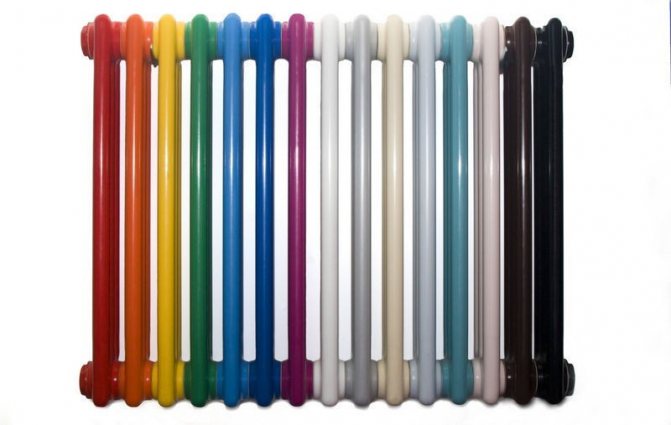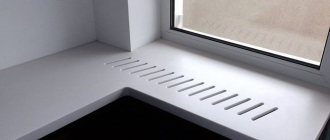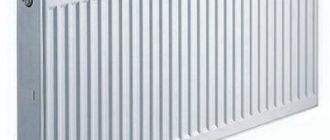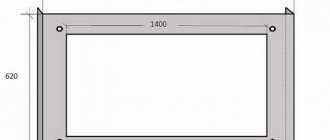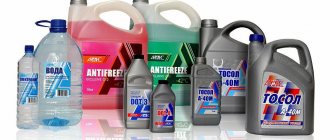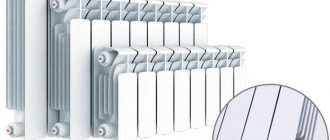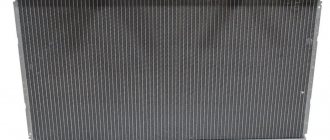Choosing a paintwork
Installing new batteries is costly. Sometimes there is no possibility of installation from the technical side. It is easier to paint the outside of the heating device if it still serves well.
The restoration itself will not cause difficulties, but this does not mean that you can purchase any composition and immediately begin to restore the battery. The paint should also be selected according to certain characteristics, and the radiator itself should be prepared responsibly. If you close your eyes to this point, the new coating will not last long, and soon you will have to refresh the structure again.
An old cast iron battery with climbing paint looks completely unattractive. In addition, the material of its body is oxidized and corroded.
When choosing a composition, experts recommend considering only options designed specifically for heating appliances. However, if there is no such inscription on the label, then you need to analyze the instructions and find information about its heat resistance.
To get a high-quality, reliable and beautiful coating, you need to use paint designed specifically for heating batteries.
Optimum paint properties for radiators:
- Heat resistance. The solution applied to the battery case must hold unchanged at temperatures of 80-90 ° C for a long time, which the manufacturer promises.
- Color preservation. This is a prerequisite, since the restoration of batteries is primarily carried out with the aim of creating aesthetics.
- Adhesion. It is necessary that the paintwork has good adhesion to the surface to be coated. The battery should look attractive as it warms up and cools down.
- Rust protection. The composition must have anti-corrosion properties so that the coating that adheres tightly to the body does not cause its destruction.
- Abrasion resistance. From direct contact with various surrounding objects, things that can be dried on the heater, the paint should not wear off.
- Security. It is important that the composition is free of substances harmful to humans.
Remember that paint for cast iron batteries, steel and others must comply with all of the above points, and not just individual ones.
Types of compositions
The technical component of the paint is the most important point to pay attention to. However, aesthetic parameters are also not in the last place.
Pros of acrylic compounds
Acrylic compounds belonging to the class of water-based dyes make it possible to kill two birds with one stone. An absolute plus is that it is odorless paint for radiators, quick-drying (about half an hour at room temperature), safe for the human body, characterized by moisture repellency. The composition forms a durable coating that is resistant to mechanical damage.
The aesthetic and technical characteristics of acrylic paints are perfect for heating appliances.
And also an important point - they do not lose their appearance at high temperatures for many years. Within 7-8 years, batteries will not turn yellow, cracks will not go, paint will not peel off.
The whiteness ratio of odorless acrylic paint for heating radiators is 96%, the color comes out quite bright, the surface looks like plastic, with a slight sheen.
Properties of alkyd paints
Alkyd solutions are heat-resistant, so they are also used for painting radiators.They are even stronger than acrylic paints, protect heating devices from corrosion processes, fit perfectly on the surface, and form an even coating.
At the same time, they are not as safe as water-based formulations. The solvent that is included in the composition does not smell very pleasant, it often stays in the room for at least a day. Drying is rather slow, and the characteristic odor may be present in the future.
Such alkyd compositions can only be used in rooms with good ventilation; it is recommended to leave the room while the smell dries and wears off.
Another big disadvantage is that the solutions retain their own color for a short time, and over time they begin to take on a yellow color. When you decide to buy exactly alkyd paint, then choose a composition that forms a glossy finish. In this case, the white battery will last longer, almost 20%, compared to matte or semi-matte solutions.
Other types of ink materials
For painting radiators, compositions are produced, based on aluminum and silicate resins, which form a dense and elastic layer on the surface. Cracks do not appear on it, even with temperature drops. Silicate materials have high adhesion, do not require surface priming, and are designed to function at high temperature conditions.
Another variety is hammer, from the class of alkyd compounds. They form a rather interesting, special coating. After painting, the surface does not come out smooth, but as if slightly hammered with a hammer or with an embossing effect.
Hammer compounds perfectly hide the unevenness of cast iron batteries, and this characteristic is very useful for residents using an old heating system.
A big plus of hammer paints in their heterogeneous texture, thanks to which various irregularities, roughness and other imperfections of batteries become invisible. This property is very appreciated when it is required to paint old Soviet-type cast iron radiators, in which the rough surface will not be visible behind a special coating.
Often, silver can be used to restore batteries, which is a mixture of varnish and aluminum powder. It has excellent resistance to high temperatures and can be applied to both primers and old coatings. At the same time, the paint is characterized by a persistent odor, therefore, during its application, the room needs to be well ventilated.
You can buy silverware ready for painting. Alternatively, you can prepare the mixture yourself; for this, parts of aluminum powder are mixed with five parts of varnish.
Aluminum powder is explosive. Therefore, it is very dangerous to prepare the mixture yourself. It is not recommended to start this process if there are flammable objects and small children in the house.
Output
If you do not want to use a gas mask while painting radiators, and then wait a long time for the poisonous smell to disappear from the room, then the best solution is to use water-based enamels and paints. They are quick-drying, environmentally friendly, easy to apply and maintain, and are able to withstand the required temperatures without destroying the coating.
The video in this article will allow you to find additional information on the above topic.
Did you like the article? Subscribe to our channel Yandex.Zen
Preparing radiators for painting
Now let's figure out how to prepare and how to paint cast-iron radiators with our own hands. Preparation is required for quality painting and takes even longer than painting itself.
How do I clean old paint from a battery? Prepare radiators in this way:
- Start with a high-quality surface cleaning before painting.To do this, you need to remove the paint layer, and clean up the places with the emerging corrosion to a metallic sheen. Dust and dirt are removed with a damp cloth, old paint is removed with a spatula and special cleaning solutions.
- Radiators are painted with rinsing solution, which are later covered with a softening film. Then this paint can be easily removed with a spatula, a grinding machine or a metal brush that is put on a drill.
- It is recommended to wear construction gloves on your hands, protect the respiratory tract with a respirator or gauze bandage.
- Then the surface of the radiator is cleaned with sandpaper, degreased with some weak alkali solution.
- An anti-corrosion primer is applied to a high-quality cleaned surface. The solution will also increase the adhesion of the paint to the body of the heating structure. For this, an alkyd-based primer is best suited.
Now you know in general terms how to manually clean old paint from a battery. Remember that the primer must have anti-corrosion properties (information about this can usually be read on the can), otherwise, after a certain time, rust will again make itself felt. On a high-quality cleaned surface, the coloring solution will fall as needed.
To prepare everything qualitatively for painting, you need to remove the old paint from the battery, remove rust, remove dust and dirt.
Currently, the construction market offers a large selection of paint solutions that already contain a primer and a rust converter. Their advantage is that their application to radiators does not require preliminary preparation of the base.
Painting process
How to paint heating batteries with your own hands with high quality? It is worth saying that the process should be carried out with the heating turned off, otherwise in some areas the paint will dry very quickly, lie unevenly, form smudges that will look unattractive. Of course, you can buy a special dye solution that is used on warm batteries, however, it can lie unevenly if the heating is not turned off.
And yet, if you are not afraid of trouble and are looking for what paint can be used to paint hot radiators, then there is always a choice of solution. You can consider paint for yourself, for example, from Radikor. The coloring solution is applied to structures heated to +60 ° C, dries on hot heaters in less than one hour.
Now radiators are painted in colors that best match the overall interior design of the rooms.
When there is no other possibility, but it is necessary to paint the heating battery during the heating season, then you should at least shut off the supply of warm water yourself or call the housing office with this request. The temperature heating of batteries in this way can be significantly reduced.
You have decided on the dye solution, figured out how to remove the old paint from the radiators, now is the time to start the dyeing process:
- First of all, you should think about the safety of the flooring from dirt and the solution itself. You can put some kind of paper or fabric under the radiators.
- Then you need to choose small brushes with soft bristles, one is straight, and the other is curved, for painting in hard-to-reach places.
- It is worth starting to paint first the upper part of the radiator, then heading down. Painting is carried out from all sides: initially internal overlap, then external in order to avoid getting hands and clothes getting dirty.
- Two color coats are applied alternately. Remember that two thin coats are better for paint than one thick one. Because only in this case, you can count on a uniform and high-quality coating.
You can also spray or spray the batteries.
When using heat-resistant paint from a spray can, the process will be more convenient and faster, the coloring agent will lie in a thin, smooth layer.
If you decide to use a spray gun for painting, then it is better to remove the heating radiator. This will allow better paint over all areas. Restoration with a spray can be carried out easily and with minimal time costs. As a rule, instructions for using the can is given on the label. The main rule is to perform zigzag movements up and down at a distance of approximately 30 cm from the surface of the body.
Paint application technology
How to paint radiators? The process is not as simple as it might seem at first glance. The most important thing is that painting cannot be carried out during the heating season. This is fraught with the fact that the paint layer will be applied unevenly. In addition, the likelihood of material delamination will increase.
If the paint is chosen by you, then after waiting for the end of the heating season of 2020, you can start applying it.
- A plastic film is laid under the radiator as a floor protection.
- You will need two types of brushes: regular and curved for painting hard-to-reach areas. Brushes should have small soft bristles.
- The process should start from the top, gradually moving down. First, the inner surfaces are painted over, then the outer ones. There is one rule that masters use: it is better to apply paint in two thin layers than in one thick one. This will increase the possibility of even coloring.
The heating radiator can also be painted with a paint can or spray gun. In the first case, you will have to use the instructions on the package; in the second, you will have to remove the device and paint it in another place.
Should you paint aluminum radiators?
All of the above information with recommendations related to painting radiators made of cast iron, copper, steel. The question arises: how is the painting of aluminum heating batteries carried out? And here is the second question: is it necessary to do this at all? Currently, aluminum devices are painted in factories by professionals with a special powder paint. Home restoration will not provide a reliable, beautiful finish.
In addition, if the battery still has a warranty, then after painting the manufacturer's warranty will not be valid. However, rarely would anyone think of painting a new structure. When the device is damaged during transportation or installation, cracks and chips appear on it, which significantly spoil the appearance. In this case, you can apply auto enamel.
It is worth saying that car enamel fits well and dries quickly only on warm batteries. The drying time at 130 ° C is 20 minutes, and at 20 ° C - two days. It is worth working in a respirator, the room should be well ventilated, paint should be sprayed at a distance of 30 cm from the surface. Do not keep the jet in one place for a long time to avoid smudges.
Radiators made of aluminum or structures made of bimetal, where the outer part of the case is aluminum, it is almost impossible to paint the house yourself.
You can also remove chips and dents from an aluminum battery using automotive putty. To do this, it is necessary to degrease the surface in advance, treat it with a primer. Then apply with a brush the putty of the required color. Do you want to completely change the color of the radiator? It is powerful to paint a radiator over old paint. It is necessary to degrease and prime the surface, apply two layers of paint. You can paint batteries with water-based paint and alkyd paint from a spray bottle.
Why is the paint swelling on the heating radiator?
If bubbles appear on the radiator, this means that in some places there is no adhesion of the coloring material to the body, the film of the solution lags behind the surface and forms a swelling.
Possible reasons:
- an alkyd or oil battery paint was applied to a wet surface;
- moisture has entered through the outer wall;
- the application technique is incorrectly selected;
- for painting, tools that were not suitable for the purpose were used.
How to solve this problem:
- Grind the surface at the place of the bulge, treat it again with a putty, re-grind and repaint with a high-quality dye solution.
- If the imperfections are visible on the entire surface, then it is required to remove the source of moisture (if possible), then clean, prime and repaint the case.
Radiator paints
Technical requirements
In order for the paint to protect the heating radiator from damage, and also to retain its original appearance for a long time, it must meet the following requirements:
- Intended for painting metal,
- Protect against corrosion,
- Resistant to abrasion and cracking,
- Be heat-resistant (when using water as a heat carrier, maintain a temperature of at least 100 0C).
In addition, it must be non-toxic (without impurities harmful to humans).
Battery painting
Different types of paint
The heating radiator can be painted:
- Enamel. Enamels are inexpensive and have a wide range of colors to your choice, but they do not tolerate high temperatures and reduce the heat transfer of the device. They dry for a long time, smell unpleasant and can only be painted with a cold radiator.
- Acrylic dyes. They are odorless and dry quickly; they can even be applied to a hot radiator. They do not last long, since they have a low coefficient of adhesion to the painted surface and may crumble over time. After drying, they change color slightly.
- Alkyd paint. Heat-resistant, fits well on the surface, but dries for a long time and smells unpleasant.
- Special paint for radiators. It can withstand any rise in temperature, so it can be used to paint even hot heating elements. Dries quickly, does not reduce the heat transfer of the device and does not turn yellow over time. It is produced in a limited range of colors and is more expensive than other types.
Special heat-resistant enamel
Interesting! The color of paint for radiators can be any - light or dark, suitable for the design of the room. But experience shows that for better heat dissipation, it is better to use darker shades.
How to navigate the range of paints and varnishes
The Russian building materials market is replete with offers for imported and foreign products. However, you cannot go to the supermarket, buy the first compound you come across and cover the heating radiators. For the convenience of selection, modern products have a classification and description of the main parameters. Main division:
- varnishes and paints for outdoor use;
- interior paints (for interior work).
Each coating is designed to handle specific materials. For example, varnish or enamel on wood is not suitable for painting radiators. In addition, any surface is pre-treated with a specialized primer so that the paint does not curl, does not peel, does not darken from reaction with the surface.

The modern market offers many varieties of paints
There are conventional coatings and heat-resistant ones. Of course, radiator paint falls into the second category. A can with a heat-resistant coating must indicate the maximum temperature in degrees - 80, 100, 120 or 150. It can be used to process metal products themselves under a coolant, and adjacent surfaces.
Important! Before painting with even the highest quality paint, old pipes and radiators must be prepared in advance - to clean up the places that have begun to turn red, peel and rust. To avoid these troubles later, it is important to choose a specialized heat-resistant paint for the radiator coating.
In a residential area, it is important that after renovation, the smell of paint is non-toxic and quickly disappears with normal ventilation. This is especially important in a room with allergy sufferers or asthmatics. But it is also pleasant for ordinary people when the batteries dry quickly, do not stick, and immediately after repair, you can forget about problems with painting. Therefore, the correct choice of coverage is so important.
Preparing the radiator for painting
Before painting heating devices, they must be prepared accordingly:
- Remove dust, dirt and grease.
- Remove old paint layers. This must be done, since each new layer reduces the heat transfer of heating and lies on top of the previous layers ugly. It can be done:
- mechanically using metal brushes and sandpaper,
- chemically using solvents or fatty acids, observing safety precautions.
- Apply a layer of special anti-corrosion primer.
Attention! The primer should be selected to match the type of paint you choose. In this case, it is better to choose paint and primer from the same manufacturer.
Painting devices from different materials
Heating batteries made of different materials have their own painting characteristics:
- For coloring cast iron, you can use universal enamels. Before painting cast-iron batteries, it is better to turn off the heating. Paint dries faster on hot surfaces and may wrinkle and form uneven spots. If it is impossible to turn off, the painting is applied to the radiator in a thinner layer.
- Steel, aluminum and bimetallic batteries are manufactured with an already applied layer of factory powder coating, so painting them at home is quite problematic. Before painting such a radiator, you need to carefully clean it with a grinder. For painting it is better to use alkyd enamel or acrylic (acrylate).
Painting cast iron appliances
Remember! For cleaning non-ferrous metals from old paint layers, it is better to use a mechanical rather than chemical method. Chemical solutions can react undesirably with the radiator surface.
plusteplo.ru
Choice of paint
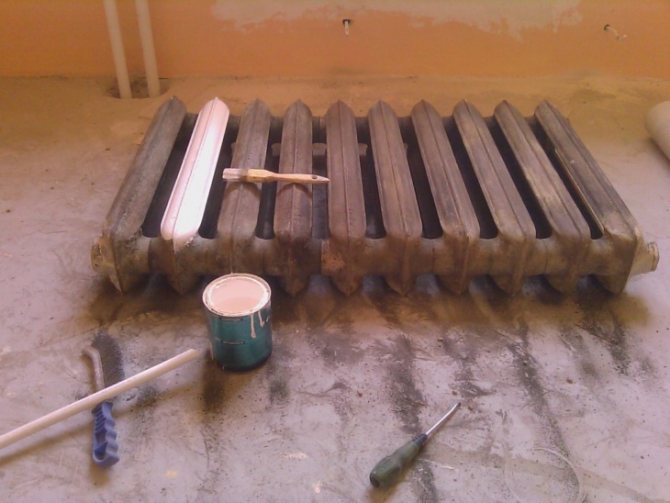

Heating radiator painting process
Colored materials are selected depending on what the radiators are made of. Various metals and alloys are used for their manufacture. Therefore, you need to pay attention to the following:
- Enamels are good for cast iron pipes. Before you start painting, the heating must be turned off. This is done because, at high temperatures, the ink dries quickly, but will instantly begin to wrinkle. In addition, spots are formed on the surface of the pipes. If for some reason it is not possible to turn off the heating, then apply the paint in a very thin layer. It is better to use a thinner.
- Aluminum, steel, bimetallic radiators are produced with a finished surface. It is coated with a protective powder. This makes it very difficult to paint again. Before applying paint, you will need to clean the surface with a sander. You should choose alkyd enamel or acrylic.
Types of paints
It is wrong to think that a radiator for heating can be coated with any paint with a high quality indicator or significant cost. So, before it was often used precisely oil or aluminum paint for heating radiators. Considering them the best suitable option for this device, use was ubiquitous.
It is unacceptable to paint radiators using such substances in these conditions, since their function does not imply protection of the metal surface at high temperatures. Thus, the paint on radiators quickly fades, cracks and even peels off, requiring re-processing.
Imperfect options were replaced by paints more suitable for thermal elements.The best options are the following types of enamel:
- Alkyd. This composition can be used at temperatures no higher than 150 degrees. When the temperature rises, the color gamut does not change. The paint has an unpleasant odor, which disappears after one week after dyeing. The cost is quite high.
- Acrylic paint for radiators. It is an odorless paint that can withstand approximately 80 degrees. Only white paint is on sale, to which a dye is added. Affordable price and availability of the product often take it to the first place.
- Silicone-aluminum. Long-term use can be up to five years without re-coating. The range of temperature conditions reaches 500 degrees. The elasticity and adaptability of the composition to thermal expansion and contraction make the enamel practically invulnerable. The cost of such a substance is quite high, while an unpleasant odor is observed, which is retained for a long time. Such analogs dry quickly.
- Aluminum with heat-resistant varnish. The people call this paint silver. Used at a maximum temperature of 200 degrees. It should be applied only to a prepared heater and preferably used in non-residential premises. The composition contains many variations of petroleum products, which makes the enamel environmentally friendly. It smells unpleasant and takes a long time. The cost is moderate, the availability is wide.
The advantage of such paints and varnishes in comparison with standard options is obvious. The paint for heating radiators cannot be completely odorless, but there are other positive characteristics.
The above listed compositions are resistant to thermal influences, wear-resistant during operation and do not have a persistent unpleasant odor.
paints and varnishes
33 votes
+
Voice for!
—
Against!
Heating radiators last more than 50 years, but at the same time their outer coating will last much less. The coating can and should be restored. Do it yourself or call a master - it's up to you. The fastest and easiest way to "bring beauty" is to paint the radiators.
In the Loft style, cast iron batteries harmoniously act as an element of the interior. In this case, the paint must be matched to bronze or brass. When choosing a paint, you need to pay attention to its technical and operational characteristics.


When painting, it is worth remembering that some compounds increase (oil paints), and some reduce (paints that contain metal - aluminum, lead) the heat transfer of the radiator.
Content
- Preparing video radiators
- How to choose battery paint?
- Painting radiators video video
Radiator preparation
The most common radiators in Soviet times were cast iron batteries. Probably, the service life of these radiators is equal to the service life of the apartment. But they, like any thing, need care. They are not whimsical in operation, but the appearance needs to be updated.
The preliminary step is to clean the battery from dust residues, previous coatings and rust. Processing must be carried out in several ways:
- mechanical - scrape off dust, paint and rust with a stiff brush with metal bristles and sandpaper, you can use a power tool to facilitate the task;


- chemical - special solvents that soften the paint, and it is also necessary to use a corrosion inhibitor.
After cleaning the surface of the heater, it must be degreased. To do this, you can use a 1% solution of ammonia, soda solution or household detergents.
The surface of a cast-iron battery very often has roughness and chips, which must be primed and leveled with a putty, and then primed again.The metal primer must be from the same manufacturer from which you will be using the paint.
How to choose battery paint?
The main criterion when choosing a paint for heating radiators is its heat resistance. Most modern high-quality materials can withstand temperatures up to +80 ° C. For heating radiators, this parameter should be at least 100 ° C. These paints are specially marked. At the same time, the paint should have greater wear resistance and not release toxic substances when heated.
For painting heating devices, they produce:
- acrylic enamels - made on the basis of polyacrylate. They have a glossy structure and last up to 20 years.
- alkyd enamels - paints based on polyhydric alcohols. They have a wide range of colors. The service life is 3-5 years. The main disadvantage of enamel is solvent fumes, which are toxic and have an unpleasant odor.
- water dispersion paints - developed on a water basis, it is odorless paint for batteries, dries well. It is necessary to use introductory dispersion paints on a mineral basis. The service life of the coating is up to 10 years.
- silicate paints - developed on the basis of a suspension of pigments, hardeners, silicates and water glass. They are highly resistant to heat and wear. Service life up to 20 years.
Each material has its own pros and cons. Which paint for batteries is better is up to you. In residential premises, it is better to use paints, the solvent of which is water, they are completely non-toxic and odorless.
Radiator painting
The optimal time for painting batteries is the time of repairs in the apartment. It is advisable to paint the batteries after the end of the heating season. If you paint during the heating season, you must close the inlet valve or the thermal head of the radiator and wait until it cools down. If you paint a hot battery, the paint will drip in an uneven layer, and wrinkling of the surface film may form due to the excessively rapid drying of the solvent. You can paint hot radiators with special compounds, but they are much more expensive.
Before starting to paint, care must be taken to protect the floor and walls from accidental paint splashes. To do this, use unnecessary paper or cloth. If such material is not found on the farm, it is necessary to purchase construction plastic wrap. If painting is done from a spray can or using a spray gun, it is recommended to cover or move the nearby interior items.
It is necessary to start painting the radiator from hard-to-reach places and various recesses. To do this, use special brushes with a curved handle.
It is worth applying paint in a thin layer, you should adhere to the rule: two thin layers are better than one thick one. It is recommended to apply the next layer on the previous one after the paint has completely dried.
Using the art of decoupage, a cast-iron radiator will turn into a pretty piece of interior decoration of the room. The decoupage technique will allow you to realize the most daring and incredible ideas.
Answering the question - how much does it cost to paint a battery? - the answer will be simple and concise - a little time and desire.
Remember that regular renewal of the protective coating on the radiator prolongs their service life and the service life of the entire heating system as a whole.
What paint is better to choose
The aesthetic appearance of the radiator will largely depend not only on the cost of the chosen paintwork, but also on the compatibility with the material of the radiator itself, as well as on the features of its design. What paint to paint? For primary staining, it is better to use glossy options.It is matte paint for painting heating batteries of a repeated type that is used - its base will hide all the irregularities and imperfections of the radiator.
Consider examples of coloring different types of radiators in accordance with their characteristics:
- Paint for cast-iron heating radiators has many nuances when painting, which relate to irregularities and not quite aesthetic joints, seams. In most cases, even matte paint does not hide all the nuances. The only correct solution would be to use colored paint that repeats the shade of the interior design of the walls. If there is a need to paint the battery exactly in light colors, then the base of the device is pre-filled.
- It is better to paint aluminum and bimetallic radiators with powder paints, but not white. The downside is that processing at home is almost impossible. First, you need special tools. Secondly, in order to perform high-quality staining, special skills are needed.
- Spray paints, that is, paints in spray cans, are the most popular at the present stage. This feature is inherent in the fact that the method of applying the product to the surface is the simplest. The main thing is to cover the wall with some material so that it does not get dirty. It is often necessary to apply at least two coats to level the surface. It is a quick drying option.
It is better to seek the help of a specialist when choosing a paint. The seller will be able to tell you which paint is best correlated with a particular type of radiator. It is necessary to take into account the preferences that relate to the design of the interior design.
Often, several types of paints can be used to create a visual combination in relation to tone or color. It makes no sense to single out any one section of the battery.
The choice of paint: what and why
When choosing paint, pay attention to the label: the phrase "paint for heating radiators" should be there. Sometimes it is written in large print, sometimes in small print in the "scope" section. If there is no such phrase, it is better to refrain from buying.
And one more thing: the manufacturer must be indicated. Some craftsmen almost one-on-one copy the design of well-known companies. But, naturally, they “forget” to write the name of the company. If the manufacturer is not specified, it is better not to buy paint. Otherwise, you risk getting a very persistent odor that lasts for weeks. Some, after such a coloring, saved themselves with a wash, which also does not smell like roses. They removed the newly applied layers, and only then did the smell go away.
Matte or glossy
Which paints are better for radiators: glossy or matte? There are two sides to this. On the one hand, when painting an imperfect surface with glossy paint (for example, a cast-iron radiator), all the flaws come out. With a bright shine, they become very noticeable. If you use matte, the look gets better.
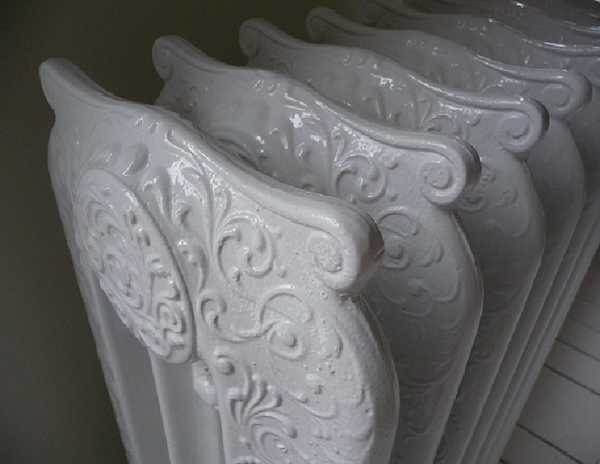

On an ideal surface, it is better to use glossy or semi-gloss paints - they do not gray out over time
But matte enamels turn gray. This is due to the fact that the surface is slightly porous (due to the dullness of the coating), and the pores are clogged with dust. Therefore, it is usually recommended to take a glossy or semi-gloss paint for radiators.
Cast iron radiator paint
If you paint cast-iron radiators of the MC-140 type with glossy enamel, all the surface irregularities are visible: the gloss enhances them even more. If you take matte, it will turn gray. Dead end? But no. There are several options for solving the problem. Choose the most suitable one:
- Paint with colored paint. In general, from a design point of view, white radiators only work well on white or very light walls. In all other cases, they are recommended to be tinted to match the walls (or a couple of tones lighter / darker).So, if your walls are not white, you can paint the cast-iron radiator with colored matte paint, and not be afraid that it will turn gray over time. Consider the use of hammer paint as one option (see below): due to the resulting pattern, defects will not be visible. Read about decorators' recommendations for decorating radiators here.
- If you still need white paint, you can paint it matte, but put up with the fact that after a couple of years you will have to repaint.
- Another way is to level the most noticeable pits with a putty. For this, epoxy or polyester car putties are used. They are applied to cleaned, degreased and primed metal. After drying, they are cleaned with a sandpaper, well cleaned from dust with a dry clean cloth, and then painted. In this case, cast iron will look good even with gloss or semi-gloss. However, such processing will take a lot of time: a painstaking task. But the result is worth it.
Now paint for cast iron batteries will not be a problem for you - choose what you like best.
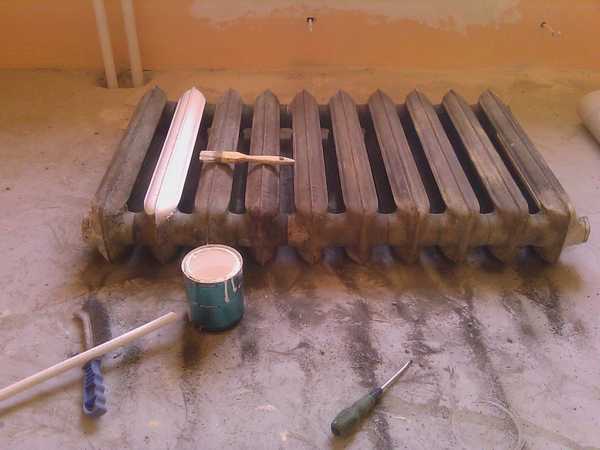

Cast iron battery paint is not an easy choice
Preparatory work
After the choice of paint for the radiator is made in accordance with the requirements for the composition and functional features of the product, you can proceed to the preparatory stage. It consists of the following actions:
1. First, it is worth treating the surface of the radiator. Secondary painting is usually performed, so it is important to accurately assess the condition of the radiator before processing. If at least five layers of paint have already been applied to the battery, then it is better to remove the excess with the help of mechanized cleaning.
2. If the previously applied layers are severely damaged, if the paint is cracked or peeling, it must be completely removed to the very base of the metal. For this, special machines or chemical flushing agents are used. This procedure should be done especially well.
3. In the case when there are no more than three layers, it is enough to process the surface with emery paper. It is worth choosing fine-grained. All streaks and drops that have formed as a result of preliminary staining are preliminarily cut off. It is necessary that the surface is smooth, without the slightest roughness.
4. After sanding, processing is carried out with chemical agents that degrease the surface. This can be done with acetone or solvent. Often this work requires several degrees of processing. Only then is the enamel applied to the surface.


